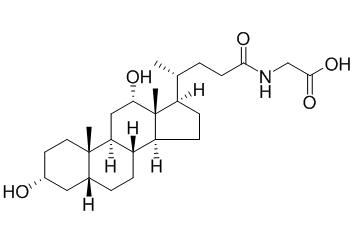Glycodeoxycholic acid
Glycodeoxycholic acid levels could as prognostic biomarker in acetaminophen-induced acute liver failure patients. Glycodeoxycholic acid can induce the apoptosis of SMMC-7721 cells.
Inquire / Order:
manager@chemfaces.com
Technical Inquiries:
service@chemfaces.com
Tel:
+86-27-84237783
Fax:
+86-27-84254680
Address:
1 Building, No. 83, CheCheng Rd., Wuhan Economic and Technological Development Zone, Wuhan, Hubei 430056, PRC
Providing storage is as stated on the product vial and the vial is kept tightly sealed, the product can be stored for up to
24 months(2-8C).
Wherever possible, you should prepare and use solutions on the same day. However, if you need to make up stock solutions in advance, we recommend that you store the solution as aliquots in tightly sealed vials at -20C. Generally, these will be useable for up to two weeks. Before use, and prior to opening the vial we recommend that you allow your product to equilibrate to room temperature for at least 1 hour.
Need more advice on solubility, usage and handling? Please email to: service@chemfaces.com
The packaging of the product may have turned upside down during transportation, resulting in the natural compounds adhering to the neck or cap of the vial. take the vial out of its packaging and gently shake to let the compounds fall to the bottom of the vial. for liquid products, centrifuge at 200-500 RPM to gather the liquid at the bottom of the vial. try to avoid loss or contamination during handling.
J Ginseng Res.2022, 46(1):104-114.
Front Microbiol.2020, 11:583594.
J Korean Soc Food Sci Nutr2020, doi: 10.3746.
Fitoterapia.2024, 175:105958.
Sci Rep.2019, 9(1):4342
Hortic Res.2023, 10(9):uhad154.
Cell Death Differ.2021, 1-8.
Hum Exp Toxicol.2023, 42:9603271231171642.
Int J Mol Sci.2022, 23(21):13406.
Viruses.2021, 13(11):2118.
Related and Featured Products
Chinese Journal of Clinical Laboratory Science, 2009, 27(3):167-169.
The effect of glycodeoxycholic acid on P53 expression in the apoptosis of SMMC-7721 cells[Reference:
WebLink]
To investigate the effect of Glycodeoxycholic acid(GDCA) on apoptosis of and P53 expression in SMMC-7721 cells.
METHODS AND RESULTS:
Apoptotic rate was examined by Annexin V.P53 mRNA was analyzed by RT-PCR,and P53 protein was measured by immunohistochemistry technique.Compared with the control,SMMC-7721 cells treated with GDCA had significantly increased apoptotic rate in a dose-and time-dependent manner.After treated with 200 μmol/L GDCA,the apoptotic rates of the cells at 48 h and 72 h were(7.67±2.35)% and(12.93±1.48)% respectively.When the GDCA concentration was raised to 400 μmol/L,the apoptotic rates of the cells at 48 h and 72 h also increased to(13.14±2.56)% and(14.22±2.11)% respectively.The p53 mRNA in SMMC-7721 cells was up-regulated,whereas the mutant P53 protein was obviously inhibited after the cells were treated with GDCA.
CONCLUSIONS:
GDCA can induce the apoptosis of SMMC-7721 cells.
Toxicol Sci. 2014 Dec; 142(2): 436–444.
Glycodeoxycholic Acid Levels as Prognostic Biomarker in Acetaminophen-Induced Acute Liver Failure Patients[Pubmed:
25239633]
Acetaminophen (APAP)-induced acute liver failure (ALF) remains a major clinical problem. Although a majority of patients recovers after severe liver injury, a subpopulation of patients proceeds to ALF. Bile acids are generated in the liver and accumulate in blood during liver injury, and as such, have been proposed as biomarkers for liver injury and dysfunction. The goal of this study was to determine whether individual bile acid levels could determine outcome in patients with APAP-induced ALF (AALF).
METHODS AND RESULTS:
Serum bile acid levels were measured in AALF patients using mass spectrometry. Bile acid levels were elevated 5–80-fold above control values in injured patients on day 1 after the overdose and decreased over the course of hospital stay. Interestingly, Glycodeoxycholic acid (GDCA) was significantly increased in non-surviving AALF patients compared with survivors. GDCA values obtained at peak alanine aminotransferase (ALT) and from day 1 of admission indicated GDCA could predict survival in these patients by receiver-operating characteristic analysis (AUC = 0.70 for day 1, AUC = 0.68 for peak ALT). Of note, AALF patients also had significantly higher levels of serum bile acids than patients with active cholestatic liver injury.
CONCLUSIONS:
These data suggest measurements of GDCA in this patient cohort modestly predicted outcome and may serve as a prognostic biomarker. Furthermore, accumulation of bile acids in serum or plasma may be a result of liver cell dysfunction and not cholestasis, suggesting elevation of circulating bile acid levels may be a consequence and not a cause of liver injury.



